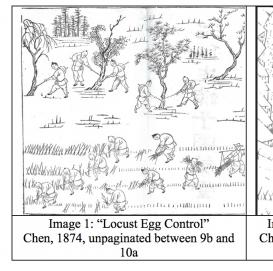Adapting Environmental Relations in Seventeenth and Eighteenth Century China in Terms of Locust Uncertainty
by David Bello
Five terms (short period of drought; laying eggs; flying locusts; rustic foolish/ ignorant commoners; disaster relief/disaster readiness) have been selected to establish a context of “locust uncertainty,” which exemplifies the larger category of environmental uncertainty during the first half of the Chinese Qing dynasty (1644–1912). Along with flood and drought, locust plagues were considered one of the three main causes of “serious famine” by traditional authorities. Consequently, locust control measures, like those of water control, were taken seriously by successive Chinese governments for reasons of food security and, by extension, legitimacy. As the terms establish, however, such control was elusive and subject to considerable uncertainty generated by the dynamic interactions of humans with their surroundings.
“Uncertainty” is, consequently, experienced by humans as a lack of predictability for purposes of, ideally absolute, state control of non-human ecological systems. The state normally conceives of any persistent uncertainties in anthropogenic terms that center on official malfeasance and peasant ignorance. In qualified contrast, society’s perspective often appears, indirectly, as a locust uncertainty manifesting economic and religious concerns. There is, consequently, a range of locust “uncertainties” that emerge. The origin of some, such as climate, are substantially ecological; others, such as jurisdictional responsibility for an outbreak, substantially social. In practice, however, the ecological interacts with the social to form a larger environmental uncertainty encompassing both.
The behavior of locusts was integral to the degree of uncertainty pervading human relations with plants, animals and climate. Locusts sprang from climate oscillations between flood and drought and from the physically transformative effects of the neurotransmitter serotonin, which changes solitary grasshoppers into gregarious winged locusts (“density-determined phase polymorphism”). The terms listed represent human adaptations to the uncertainty generated by these dynamics of locust behavior: successive wet and dry conditions within a certain range prepare, and can expand, favorable reproductive habitat from which flying locusts may emerge to intimidate peasants faced with excessive demands generated by state disaster relief and readiness policies. The five terms thus outline both planning and the larger context of uncertainty to which it tries to adapt as a set of dynamic environmental relations that include humans, but are not solely constituted by them.
Prediction and planning are complicated precisely because locust uncertainty emerges from these relations, some of which are comparatively less subject to state control (ecologically as climate), some of which comparatively more subject to state control (socially as personnel administration). Under conditions of environmental uncertainty, the terms may be understood as cultural expressions in response to an ecological process only partially subject to prediction and planning. Chinese imperial administration could not wholly reduce locust uncertainty to a “people problem” of personnel management or peasant superstition, regardless of the concepts it employed. To the degree that it could not effect such a reduction, imperial state control became environmentally uncertain.


